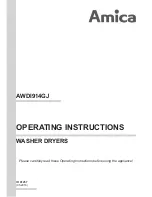
PAGE 13
FOR SERVICE TECHNICIAN’S USE ONLY
DO NOT REMOVE OR DES
TROY
8.
Check if shifter assembly is affecting the main control
DC supplies.
a.
Unplug washer or disconnect power.
b.
Remove connector
J2
from main control.
c.
Plug in washer or reconnect power.
d.
Repeat steps 6 and 7. Perform the +13VDC check inside
header J2 on the board –
do not short pins together
.
If one or more DC voltages are still missing, go to step 9.
If the DC voltages return, check for short in harness
between main control and shifter assy.
If harness and connections are good, replace shifter assembly.
9.
Main Control has malfunctioned.
a.
Unplug washer or disconnect power.
b.
Replace the main control.
c.
Reassemble all parts and panels.
d.
Plug in washer or reconnect power. Calibrate washer
and perform Quick Overview Test to verify repair.
TEST #2: Valves
This test checks the electrical connections to the valves, and the
valves themselves.
1.
Check the relays and electrical connections to the valves
by performing the Cold and Hot Valve tests under Manual
Overview Test Mode on page 9. Each test activates and
deactivates the selected valve. The following steps assume
one (or more) valve(s) did not turn on.
2.
For the valve(s) in question, check the individual
solenoid valves:
a.
Unplug washer or disconnect power.
b.
Remove console to access main control.
c.
Remove connector
J3
from main control. Refer to main
control diagram on page 12.
d.
Check harness connection to solenoid valves.
3.
Check resistance of the valve coils across the following
J3 connector pinouts:
Resistance should be 890–1.3k
Ω
.
If resistance readings are tens of ohms outside of range,
replace the valve assembly.
If resistance readings are within range, replace main control
and calibrate washer. Perform Quick Overview Test to verify
repair.
TEST #3a: Drive System – Shifter
This test checks connections, shifter motor, switch,
and optical sensor.
NOTE:
Refer to Figure 4, “Shifter Assembly Strip Circuit”
on page 14 for tests and measurements.
IMPORTANT:
Drain water from tub before accessing bottom
of washer.
Functional Check:
1.
Check the shifter and electrical connections by performing
both the Spin AND Agitate test under Manual Overview Test
Mode on page 9. The following steps assume that this step
was unsuccessful.
2.
Unplug washer or disconnect power.
3.
Check to see if basket will turn freely.
If basket turns freely, go to step 4.
If basket does not turn freely, determine what is causing
the mechanical friction or lockup.
4.
Remove console to access main control.
5.
Visually check that the J2 and J16 connectors are inserted
all the way into the main control.
If visual checks pass, go to step 6.
If connectors are not inserted properly, reconnect J2 and J16
and repeat step 1.
Shifter Motor:
6.
Remove connector
J16
from main control. With an ohmmeter,
verify resistance of the shifter motor across the following J16
connector pinouts:
Resistance should be 2k to 3.5k
Ω
.
If values are correct, reconnect J16 and proceed to step 7.
If values are open or out of range, go to step 13.
7.
Plug in washer or reconnect power.
8.
With a voltmeter set to
AC
, connect the black probe to J16-2
(N) and red probe to J16-1 (L1). Activate shifter motor by
switching between Spin and Agitate modes. Energize outputs
using Manual Overview Test Mode on page 9.
IMPORTANT:
Lid must be closed with Lid Lock enabled to run
the SPIN and AGITATE tests.
NOTE:
It will take 4–15 seconds for the shifter to change states.
If 120VAC is present, go to step 9.
If 120VAC is not present, go to step 17.
Pinout
Valve
J3, 1 & 4
Hot Valve
J3, 1 & 5
Cold Valve
Component
Shifter Motor
J16 Connector Pinout
J16, 1 & 2






































